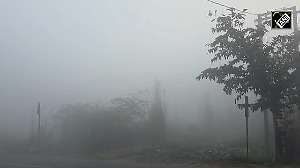The Industrial and Commercial Bank of China, China's largest lender, is set to float its initial public offer with a dual listing in Hong Kong and Shanghai later this month, to raise about $21 billion. This will be the world's biggest IPO, beating the record of Japan's NTT Mobile Communica-tions Network Inc, which had raised $18.4 billion in 1998.
ICBC is planning to float 24 per cent of its enlarged share capital and could even sell more shares by exercising the greenshoe option. After the IPO, its valuation will roughly be about $87 billion. This is almost one and half times of the collective market capitalisation of all listed Indian banks - for the 37 listed Indian banks, this is about $ 62.76 billion (Rs 2,86,859 crore).
China's second-biggest lender, Bank of China, raised $13.2 billion in June by offering 10.5 per cent of its capital to the public and the country's third largest bank, China Construction Bank, raised $9.2 billion last October. Bank of China's market capitalisation is now around $105 billion and that of China Construction Bank $ 99 billion.
In terms of market capitalisation, ICBC will still be far behind Citigroup ($140 billion), but it is a giant vis-à-vis Indian banks. ICICI Bank tops the market capitalisation chart with $ 13.59 billion (Rs 62,177 crore), followed by the State Bank of India with $11.89 billion (Rs 54,380 crore) and HDFC Bank with $6.29 billion (Rs 28,774 crore). None of the other listed Indian banks has over $5 billion worth of market capitalisation. Punjab National Bank, the fourth bank when it comes to market capitalisation, is worth just $3.62 billion.Canara Bank is worth just $2.52 billion.
While Indian banks fare poorly in terms of market value, there are some who believe this is not the right comparison. They argue it is the Price-to-Book Value (P/BV), which is important, and most Indian banks do well here. After adjusting for non-performing assets, HDFC Bank's P/BV is 5.41 times and that of ICICI Bank is 2.79 times.
UTI Bank's P/BV is 3.69; Yes Bank's 4.51 and Centurion Bank of Punjab's P/BV is 3.79. Kotak Mahindra Bank has the highest P/BV at 11.61.
Public sector banks, however, have a lower P/BV - below two times for most of them, barring a few exceptions.
The initial price for ICBC shares is not likely to be lower than 2.2 times the 2006 forecast P/BV. Most US banks trade in the range of 1.2-3.5 times. In case of European banks, the range is 2-3 times price-to-book-value.
In terms of price earning ratio, the Chinese banks are in the range of 16-24 times. The average P/E of listed Indian banks is over 14 times with HDFC trading at a P/E of 31.06 and ICICI Bank 23.64. HDFC Bank is, in fact, the second costliest Asian bank after Hang Seng in Japan.
ICICI Securities' Dipankar Choudhury attributes two reasons for the lower value. First, the interest rate risk is comparatively high and no other country has such a high level of statutory appropriation by the government. Second, government interference in the functioning of banks leads to a lower value.
The 20 per cent cap on FII investment in PSU banks is also a restriction on valuations - foreign investment in some of the private banks are as high as around 74 per cent.
The CEO of a large private bank feels that the market is discounting Indian banks' capability of exploiting the growth opportunities.
"The real challenge before the banks is that they must convince the investors that they are capable of making the most of the India growth story," he says.
Ashwin Parekh of Ernst & Young has a different explanation for the undervaluation - namely the failure of Indian banks' to value the underlying assets. "The Chinese banks had much higher NPAs than Indian banks but they also focused on the quality of collateral. Naturally, investors have the perception that there is a huge potential in the underlying assets. Unfortunately, this is the not the case in India," he points out.
Finally, Indian banks do not have the scale. ICBC has total assets of over $ 812 billion, close to the size of India's GDP! Despite such large assets, the large Chinese banks have recorded annual growth rates of over 10 per cent in total assets over the past three to four years.
State Bank of India, which accounts for almost one-fifth of total banking assets in India, however, has an asset base of only $84 billion. Unless our banks are allowed to build scale, their real value cannot be unlocked.
Reporting and disclosure of the Chinese banks have always been suspect. In May, Ernst & Young estimated that China's bad bank loans were about $911 billion, including $358 billion for the four largest banks alone. The official figures stand at$164 billion and $133 billion, respectively.
Despite this, international investors believe the potential is huge and things can only get better in China. In the case of India, it is a story of missed opportunities, an interfering government-owner and a micro-managing banking regulator.






 © 2025
© 2025